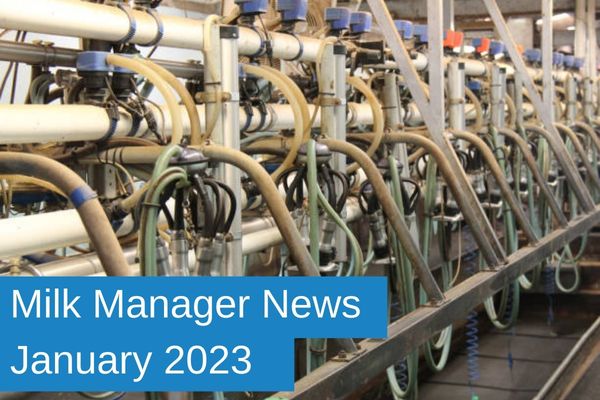Milk Manager News January 2023 – Managing the Thermoduric Count in Milk
13 January 2023Thermoduric count is one of the measures of milk hygiene quality. It refers to “heat-resistant” spore-forming bacteria that can survive the pasteurisation process. While most bacteria in milk are killed by pasteurisation, other micro-organisms, such as bacillus and clostridium which are present in the form of spores, can survive higher temperatures up to 65°C. The thermoduric count is of importance to milk processors as a high count can reduce the shelf life of milk and milk products and cause them to spoil. In recent years some processors have added thermoduric count to their payment schedule and so if it is above a certain threshold, a penalty will be applied. The threshold varies depending on the processor; some incur penalties once the count is over 1000 cells/ml.
Thermoduric bacteria can arise from the cow’s environment but can also be attributed to poor maintenance and cleaning of the milking parlour and milk cooling/storage facilities. Sources of thermoduric bacteria in housed cows include slurry, silage and bedding, and for grazing cows, soil is the main source.
The starting point to tackle a high thermoduric count is cow cleanliness and the cleaning/disinfection of teats before milking. A pre-dip product with a rapid bacterial kill should be used to disinfect teats and the teats must be dry before applying the milking unit. If cows are particularly dirty when coming into the parlour, then look at the environment and consider how often passages are scraped, how clean the cubicles are and dryness of the beds. For straw yards, mucking out every three weeks is recommended to minimise environmental bacterial numbers on the teat skin.
The milking machine and plant can also harbour thermodurics. Firstly, ensure that liners are replaced regularly. If the rubber is cracked, it will be impossible to clean. Also inspect the long milk tube from the cluster to the milk line and replace if cracks are evident. These tend to have a shelf life of around three years.
When it comes to cleaning the milking plant, the pre-rinse is vital to ensure milk residues are removed, enabling detergents to work effectively and 12-15 litres of water per unit should be used. Detergents can be rendered ineffective when biofilms build up. Biofilm is a brown, waxy film produced by bacteria which attaches to the inside of rubberware and the milk line due to inadequate cleaning and builds up over time. The presence of biofilm can make detergents ineffective and indicates that the hot wash is not at a high enough temperature, which should be between 77 to 85°C.
Initially thermoduric bacteria enter the milking plant from contaminated teats during milking and then poor cleaning of the plant and bulk tank allows multiplication of these bacteria, leading to problems with the thermoduric count. Inspect the milk sock after milking; if it is soiled then teat preparation could be improved. A high thermoduric count can also be due to inadequate cleaning of the bulk tank.
The following publication from Teagasc provides tips for controlling thermoduric bacteria in the cow’s environment, as well as milking plant and bulk tank hygiene measures.
lorna.macpherson@sac.co.uk; 07760 990901
Sign up to the FAS newsletter
Receive updates on news, events and publications from Scotland’s Farm Advisory Service

